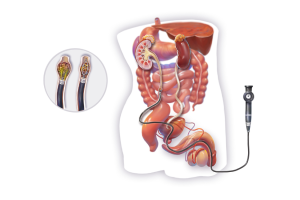Ureteroscopy

If you have ever had a symptomatic kidney stone, it’s an experience you will likely never forget. Kidney stones are some of the most painful occurrences anyone will experience, with many people likening the pain to that of childbirth. Interestingly, the pain fromkidney stones is not related to the size of the stone nor to the jagged edges that might be scraping against the kidney or ureter walls. Instead, the pain comes from the distensionand swelling of the kidney when a stone blocks the outflow of urine and forces the kidney to expand. Stones often form from the slowed urine flow through the kidneys, commonly due to dehydration, which usually worsens during the hot summer in Charlotte. This is why we are considered part of the Stone Belt of the United States.
Not all kidney stones that become symptomatic need treatment. Many patients can flush a kidney stone out of their system, especially when it is 4mm or less (the diameter of a typical ureter), by increasing their water intake while taking pain medication to manage the discomfort. For others, especially those with stones within the kidney composed of softer mineral material, ESWL or extracorporeal shockwave lithotripsy is often a great option because it is not invasive.
When is ureteroscopy appropriate?
Ureteroscopy is most appropriate when a kidney stone has become lodged in the ureter, the tube that brings urine from the kidney down to the bladder. The ureters are approximately 4 to 5mm in diameter, so a kidney stone of that size will likely become lodged and start reducing urine flow. Ureteroscopy is almost always used for kidney stones lodged in the ureters and rarely for those in the kidney.
How does ureteroscopy work?

During a ureteroscopy, a small scope (camera), either rigid or flexible, is passed through the urethra, into the bladder, and up the ureters, until Dr. Natale locates the kidney stone. Ureteroscopy does not involve any incision in contrast to the more invasive PCNL or percutaneous nephrolithotomy. Dr. Natale can mechanically break up the kidney stone using a mini jackhammer-style device. Or laser energy may be deployed to pulverize the kidney stone. Either way, it is very successful and often gets patients stone-free. During a ureteroscopy, the kidney stone is either entirely pulverized or can even be pulled out using a small surgical basket.
The Bottom Line
Ureteroscopy is a very effective procedure to address kidney stones lodged in the ureters. Patients have an excellent chance of becoming stone-free because of the direct visualization and advanced kidney stone pulverizing technology, whether laser-based or mechanical.
